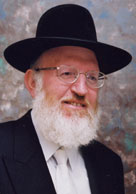Beit Midrash
- Sections
- Chemdat Yamim
- Parashat Hashavua
- Torah Portion and Tanach
- Bereshit
- Noach
Before we present a thesis, let us note a few more things. Usually covenants include two sides’ mutual commitments, yet here we are aware only of Hashem’s commitment. It is also not clear who the other side is. While we would think it is Noach, representing mankind, the Torah stresses (four times) "kol basar" (all flesh). When the Torah said that Hashem "saw that all flesh was corrupted" (Bereishit 6:11-12), Rashi says that it refers to the animal kingdom (regarding their inter-species relations). The overlap of the term kol basar and the idea of seeing links the two narratives.
The idea of seeing is stressed again in the next story. Noach became intoxicated and was lying undressed in his tent. His son, Cham, saw and did something for which his father cursed him. The main approach in Chazal is that Cham committed sodomy on his father. In contrast to him, his brothers came in to cover Noach without seeing his nakedness (ibid. 8: 20-24). We see that the difference between being fit to properly rebuild the world and not, depends on how one sees and is seen.
When describing incest, the Torah sometimes refers to it as "seeing her nakedness" (Vayikra 20:17; see also Eicha 1:8). This is also the source for the aforementioned assumption that the sin that Cham committed had to do with illicit intimacy, in this case, with another male and a father. The word keshet (bow), which can refer to a rainbow or the bow of a bow and arrow also has special significance in this context. Yaakov said about Yosef, "His bow was firmly emplaced" (Bereishit 49:24) to hint that he did not allow himself to be seduced by Potiphar’s wife.
Putting all our observations together we come up with the following. The idea of the rainbow was not that it was created for the brit. Rather it represented that the inhabitants of the world accepted, as their part in the covenant, to rein in the rampant tendency toward illicit relations that existed before the flood. Thus, it is not a new phenomenon or a reminder to Hashem, who does not forget. Rather it forms the basis for what the world needs to know is a basic foundation of the covenant with Hashem that ensures their survival. Certainly one does not choose a "partner" who is already married to another man, who is of the same gender, or is a close relative. When Cham broke this part of the covenant, there was a need for an updating of the covenant, whereby Hashem forged a special relationship with Avraham, as we will discuss next week.

The Time and the Reason to Change Leadership
Rabbi Yossef Carmel | תמוז תשע"ב

Torah-Based Law and Rav Yisraeli
Rabbi Yossef Carmel | Sivan 21 5778

Zaken Mamreh
Rabbi Yossef Carmel | 4 Elul 5767






















